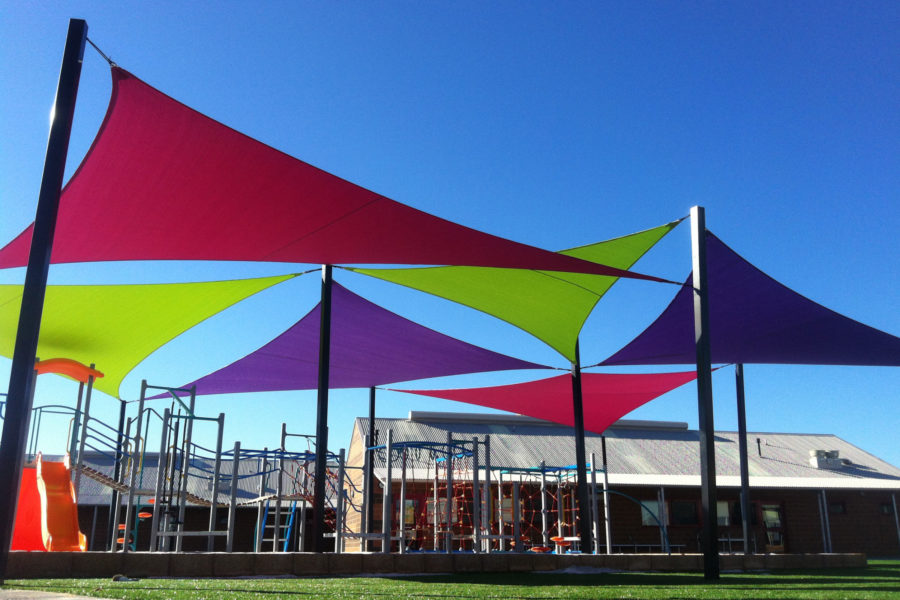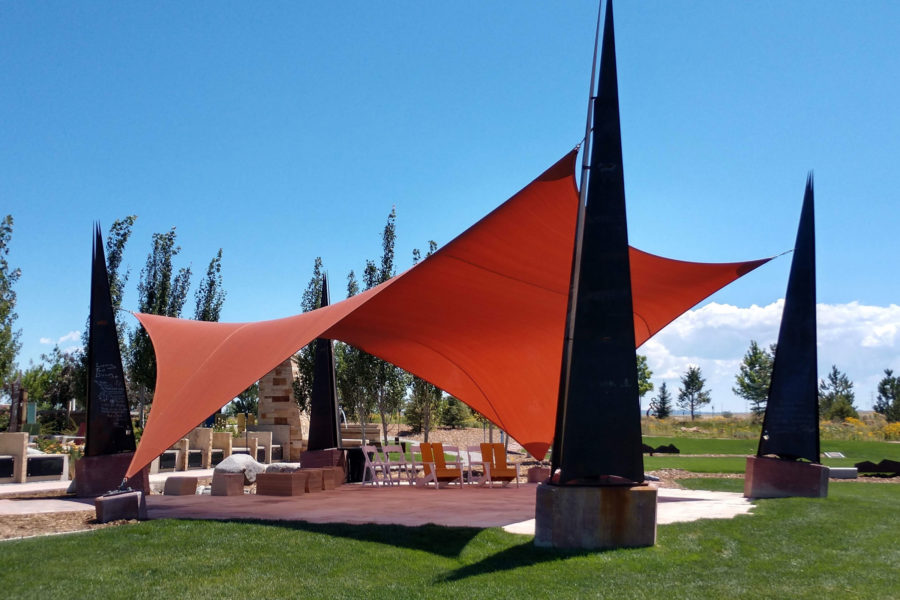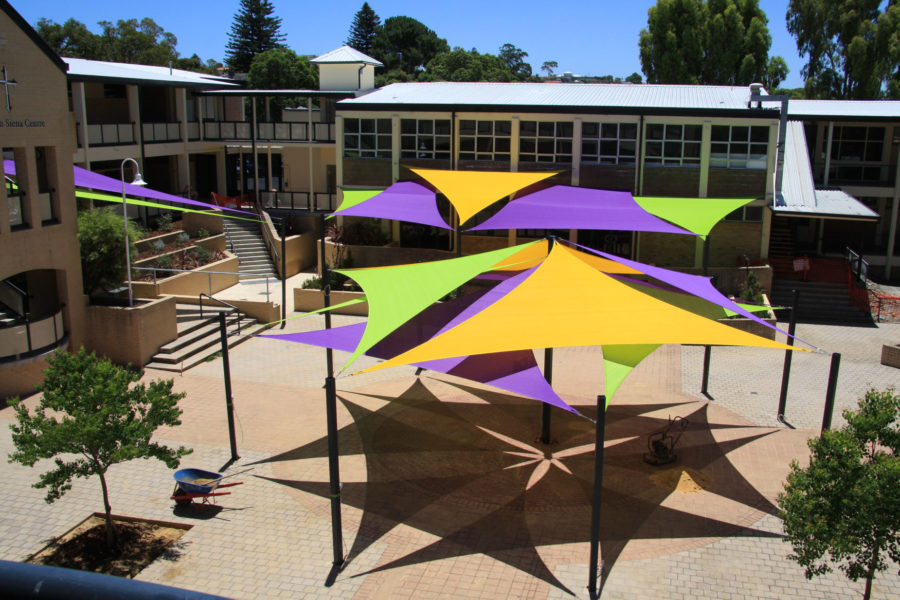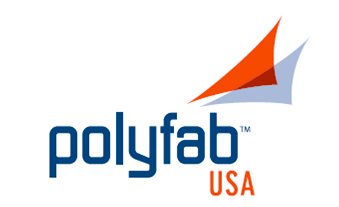Story at a glance:
- Once an Aussie-only mainstay, shade sails and structures are now outfitting buildings Stateside.
- Phthalate-free, UVB blocking, and 100% recyclable, shade fabric can endure the elements for years.
- For energy efficiency and aesthetic enhancements, commercial and residential buildings can choose from shade cloth of varying colors and fabrics.
Everywhere you look in Australia you’ll notice shade cloth—in backyards, at restaurants, even covering public basketball courts. While shade sails and shade structures have been popular (even mandated in some places) for decades in the southern hemisphere, the importance of products like these seems to just be catching on in the US, according to Steve Morenberg, managing director of Polyfab USA.
Morenberg has spent more than 40 years in the industry—the last 12 working with the shade fabric experts in Australia. “The Australians really took shade fabrics and ran with them,” Morenberg says, noting the need for protection from the sun in warmer climates. But as more people spend time outside—and in often increasingly warm temperatures—those products first developed by the Aussies are growing in demand Stateside, too.
“Product awareness has been growing over the years,” Morenberg says. “People here now for the most part know what a shade sail looks like. They’ve probably eaten under one at a restaurant. When I started in 2009 it was still a fairly new and quirky thing, but it’s becoming more mainstream now.”
In Australia almost every house has a shade sail in the backyard, and every public area is mandated to have such protection. As the COVID-19 pandemic pushed more people outside in the US, Morenberg says more people began searching for ways to enjoy their own backyards, no matter the weather. “That’s only going to spur longtime growth in the industry as people become more familiar and comfortable with these,” he says.
What is Shade Cloth?

Shadesails made from Polytex+ protect you from the sun by leisure areas and swimming pools and offer a nice alternative to flat roof timber pergolas. Photo courtesy of Polyfab USA
Founded from Australian roots, Polyfab USA has been manufacturing and supplying premium fabric and supplies for commercial, industrial, and residential shade sails and shade structures for more than 25 years, and in the US since 2008. Polyfab’s premium quality shade cloths feature excellent UVR block, are flame-retardant where noted, and are made of 100% recyclable materials. They’re also heavy metal and phthalate–free.
Polyfab offers the popular knitted fabric lines of Comtex+ and Polytex+ in different weights, depending on project needs and shade size. (The “+” designation is a new iteration of these market favorites). Smaller shades, like those you might see at a backyard patio, don’t require as much tension to perform well. Larger shades require more tension to make the fabric taut.
Comtex+ offers excellent weight to strength ratio and is ideal for medium residential and commercial projects. Polytex+ provides maximum people-protection against the sun’s heat and strong UV rays, and it utilizes the best UV stabilizers from BASF. It also provides good protection against wind, rain, and hail. Comtex+ has less shrinkage and is more stable than the earlier version, while maintaining high strength and more than 90% UV protection.
Sail Shape is Important

Polyfab USA has been manufacturing and supplying premium fabric for commercial, industrial, and residential shade sails and structures in the US since 2008. Photo courtesy of Polyfab USA
Often when people seek shade sails or shade structures, Morenberg says they consider triangles first. “If you go to a hardware store or big-box store and get a low-cost shade, frequently it’s a triangle. The problem with a triangle is it doesn’t give you as much shade.”
Polyfab USA recommends four- or five-corner shades instead. While triangles offer just a single plane of protection that can simply be tilted up or down, Morenberg says a four-corner shade allows you to twist the fabric to get a saddle shape, or what’s called a hypar. “The hypar shape is going to give you better shading,” he says. “It’s also going to give you better wind and rain resistance over the structure.” It all comes down to physics, he says.
The more elaborate shape also protects your sail from flapping in the wind. The more your shade sail flaps, the quicker it may break down. “If you have a way of twisting the shape of the sail to get that hypar shape, that saddle shape, the fabric will not flap nearly as much. It will last a lot longer. That’s one of the tricks of the trade.”
Morenberg says the curve of the fabric you see is also important, as tightening on the shade sail’s fabric or webbing causes lateral pulling all along the edge of the fabric, giving an even, consistent tension across the fabric panel. “As a designer you need to keep that in mind,” he says. “Because when you cut the curve you’re taking some of the fabric out, and so you’re taking some of the shade out. If you have a triangle, for example, and you have a curve on two or three edges, but it’s not a very big triangle, you’re going to end up with just a little strip of fabric and not very much shading. The customer is not going to be very happy with it. That’s another reason to go with a multi-corner shade sail.”
In a 20-by-20-foot space a square shade sail provides 24% more shade than a triangle. If you have to use triangles, Morenberg advises using height difference to add dimension, and add multiple triangles to add appeal.
The Benefits of Shade

Photo courtesy of Polyfab USA
While a shade sail has an unsupported span, shade structures have a supported framework; the benefits of both are clear when using Polyfab USA cloth. For starters, Polyfab’s revolutionary knitted mesh replaced the woven mesh of old, cutting down on any potential fraying. And because it’s made of high-density polyethylene, it lasts longer outdoors.
Morenberg says architects and designers concerned about the environment turn to shade sails or shade structures for several reasons—including to protect people from UV exposure, as the fabric has a UVB rating similar to sunscreen. The darker the fabric the higher the rating. The fabrics can also help you earn LEED points for your project. A certain amount of shade over a window will reduce the amount of heat gain, thereby saving a certain amount of air conditioning costs.
The HDPE shade cloth is also offered in wide widths for easier fabrication, has a long life (a 10+ year UV warranty is common), and is 100% recyclable. Hot air “breathes” through the mesh fabric, so anyone beneath it actually feels cooler than they would under a solid shade like one made of PVC vinyl.
Polyfab USA offers a seemingly endless array of color possibilities, too, with new colors to match steel and other building materials out now.




